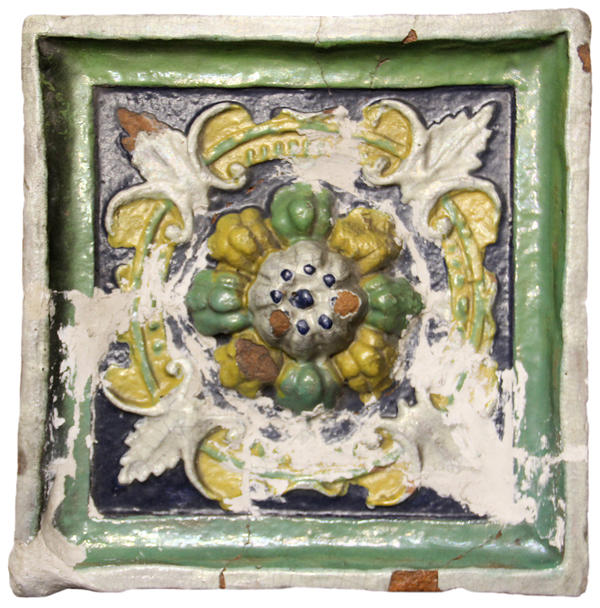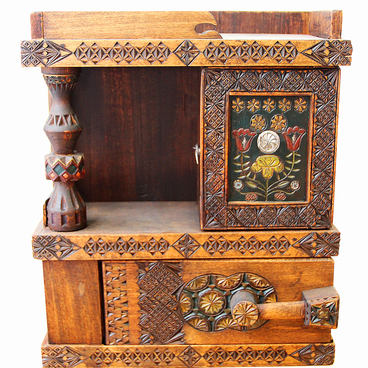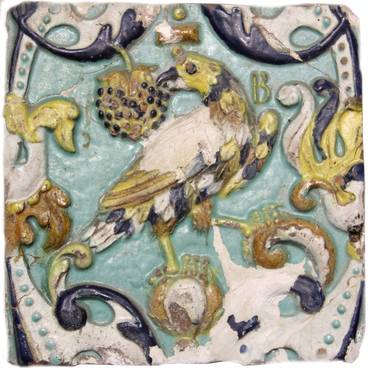The element of the tile decoration belt is one of the museum’s oldest exhibits dating back to the late 17th century. This tile was located on a wall of the gallery inside the church of Ilya the Prophet in Yaroslavl. This is a rare example of how the facade tiles were used to decorate the interior.
A glazed tile from the interior decor
Creation period
1647-1650s Interior design - 80s. 17th century.
Dimensions
29x29,5 cm
Technique
Red clay. Colored enamel
Exhibition
1
Open in app#1
A glazed tile from the interior decor
#4
#8
The Church of Ilya the Prophet was built of stone in 1647-1650s. Before that, there were two wooden temples on the place: the former, older temple of Ilya the Prophet and the Church of the Cover of the Mother of God. The new church was built with funds allocated by wealthy merchants, brothers Ioanniky and Vonifaty Skripin.
#9
The Skripin brothers moved to Yaroslavl from Novgorod during the reign of Ivan the Terrible. They conducted trade operations not only in Russia, but also abroad. The Skripins would buy Siberian fur, pearls and gems and resell it in other cities, and in return they would buy goods, which were then transported to Siberia.
#3
Both brothers were part of the so called guest hundred, an association of rich merchants of the 16th — 18th centuries. The guest hundred was the second most important Guild of merchants after the guests — merchants who received a special certificate from the czar that provided them with special rights and privileges.
#10
The Skripins hired an artel of builders to build the church. The facades of the temple of Ilya the Prophet were smooth, decorated with tile finishes painted with large flowers and herbs. The image of such flower is preserved on the museum exhibit that was a part of the interior tile decoration. At the moment, the external painting of the temple is completely lost, only the old whitewash of the building has been restored.
#11
The merchants Skripins paid for the casting of seven bells for the completed church of Ilya the Prophet, bought necessary icons, attributes for services and utensils.
#12
Around the church, the masters erected a stone fence with towers. There were shops and tents on the premises and 13 storerooms under the building. One of them was designated as the ancestral tomb of the Skripins family. Work on the interior of the temple was carried out in the 1860s.
Vonifaty Skripin’s wife, Iulita, took an active part in the construction of the temple. It was she who ordered frescoes from Kostroma artists Sila Savin and Guriy Nikitin, who worked with the Yaroslavl artel. At her invitation, well-known Russian icon painter Fyodor Zubov came to Yaroslavl.
#13
For the construction of the church of Ilya the Prophet, Patriarch Joseph rewarded the Skripins family with a part of the Vestment of the Lord, an outer garment that was kept in Moscow Cathedral of the Dormition. Such an award could be received only for special merits: a small element was separated from the shirt of Christ, the chiton, and sent as a sign of special favour. Later, in order to protect the sacred object, this practice was forbidden.
read morehide
00:00
00:00
1x
A glazed tile from the interior decor
Creation period
1647-1650s Interior design - 80s. 17th century.
Dimensions
29x29,5 cm
Technique
Red clay. Colored enamel
Exhibition
1
Open in app
Share



